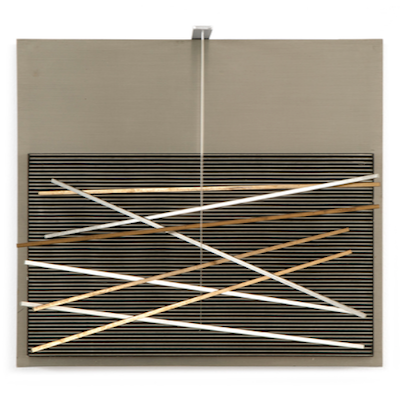
Details
Artist
Styles
Aquatint and woodcut -Printed on Somerset Satin of 180 x 135 cm. Edition of 7 // Mae West by Rita McBride is a limited edition woodcut and aquatint print created in 2010. The artwork showcases a striking interplay of geometric shapes and vivid colors. Vertical and horizontal bands in bold hues, including blue, yellow, green, pink, and black, intersect to form a grid-like pattern, evoking a test screen aesthetic. In the center, a tower-like structure of black and gray diamond shapes expands and contracts, creating a sense of movement and optical illusion. Printed on Somerset Satin paper, this large-scale piece (180 x 135 cm) is part of an exclusive edition of seven, combining McBride's architectural interest with abstract forms to create a visually dynamic composition.
Mae West, 2010
form
Medium
Size
180 x 135 cm
- Inches
- Centimeters
Edition
Price
- USD
- EUR
- GBP
Details
Artist
Styles
Aquatint and woodcut -Printed on Somerset Satin of 180 x 135 cm. Edition of 7 // Mae West by Rita McBride is a limited edition woodcut and aquatint print created in 2010. The artwork showcases a striking interplay of geometric shapes and vivid colors. Vertical and horizontal bands in bold hues, including blue, yellow, green, pink, and black, intersect to form a grid-like pattern, evoking a test screen aesthetic. In the center, a tower-like structure of black and gray diamond shapes expands and contracts, creating a sense of movement and optical illusion. Printed on Somerset Satin paper, this large-scale piece (180 x 135 cm) is part of an exclusive edition of seven, combining McBride's architectural interest with abstract forms to create a visually dynamic composition.
- Recently Added
- Price (low-high )
- Price (high-low )
- Year (low-high )
- Year (high-low )
What is kinetic art?
Kinetic art is an international movement that emerged in the 1920s and gained prominence in the 1960s, referring to art that involves both apparent and real motion. It encompasses any medium that includes movement, either relying on actual motion for its effect or being perceived as moving by the viewer. Early examples include canvas paintings designed to create optical illusions of movement. Today, kinetic art often refers to three-dimensional figures and sculptures, such as those operated by machines or those that move naturally. The movement covers a variety of styles and techniques that frequently overlap.
















